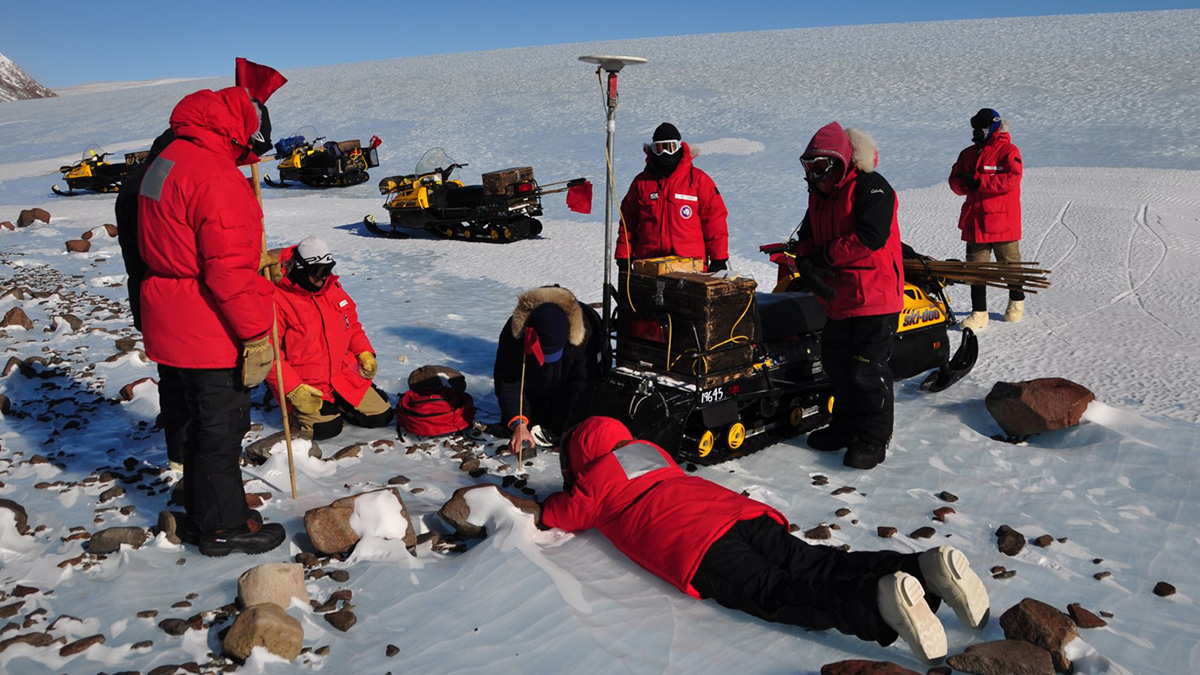Literal relics of the formation of the solar system, meteorites are prized by scientists and collectors alike. And while there’s no better place to find these space rocks than in Antarctica—nearly two thirds of the meteorites collected thus far have been found there—meteorite-hunting expeditions to the White Continent often rely largely on serendipity and the sleuthing skills of experienced participants.
Now, researchers have developed a machine learning algorithm that they suggest reliably pinpoints meteorite-rich regions in Antarctica and could therefore streamline future searches. According to the new analyses, fewer than 13% of meteorites lying on the surface of the White Continent have been recovered to date.
Black Rocks, White Landscape
Since the early 20th century, researchers have been collecting meteorites from Antarctica. Rocks from space tend to remain well preserved in the cold, dry environment, and their dark coloration stands in stark contrast to their white surroundings, said Veronica Tollenaar, a glaciologist at the Université Libre de Bruxelles in Belgium. “It’s relatively easy to spot them.”
“We hope to increase the chances of success for future missions.”
But the process of searching for meteorites over the White Continent’s expanses has remained remarkably unchanged over time. “It’s exactly how you imagine,” said Tollenaar. “You just do a grid search.”
Meteorite-hunting expeditions accordingly tend to be time-consuming and labor-intensive—teams of volunteers regularly work for weeks at a time, crisscrossing the Antarctic landscape on snowmobiles. With the new algorithm, Tollenaar and her colleagues aim to streamline the process. “We hope to increase the chances of success for future missions,” Harry Zekollari, a glaciologist at Delft University of Technology and a team member, wrote on Twitter.
Follow the Blue Ice
To focus their search, the researchers considered only specific swaths of Antarctic terrain known as blue ice areas. These regions, which collectively encompass just 3% of the continent’s surface, are prime spots for finding meteorites. That’s because they aren’t blanketed in snow—persistent winds and sublimation act in tandem to expose the ice underneath. Furthermore, the topography of blue ice areas often causes ice to flow upward in these regions, effectively transporting to the surface any meteorites trapped within deeper layers.
The team also folded three other data sets into their algorithm: surface temperature, ice velocity, and the slope of the terrain. Temperature matters because warmer conditions can cause meteorites to sink out of sight, said Tollenaar, and ice velocity is likewise important because rapidly flowing ice transports meteorites away. The effect of slope is less clear-cut, but it’s a useful parameter to include nonetheless, the team found. “Through our analyses we learned that it interacts with the other properties, and thus including it helps in making good predictions,” Tollenaar told Eos.
Tollenaar and her collaborators relied on machine learning, a more sophisticated form of analysis than simply overlaying all of the data sets. “This algorithm is able to see interactions between all of the different measurements,” said Tollenaar.
To train their algorithm, the researchers provided the precise locations of thousands of meteorites found in Antarctica. On the basis of that input, the algorithm flagged 106,687 grid cells—each measuring 450 meters on a side—as positively containing meteorites. By clustering positively flagged grid cells and retaining only regions larger than 4 square kilometers, the team defined more than 600 so-called meteorite stranding zones.
Many More to Find
“As someone who gets a grant to go recover meteorites, [I think] it’s encouraging that there [are] a lot more out there.”
To evaluate their algorithm’s output, the team compared the locations of predicted meteorite stranding zones with an independent data set containing both known meteorite stranding zones and nonmeteorite stranding zones (i.e., Antarctic regions known to have been searched by humans but that failed to yield a single meteorite). Tollenaar and her collaborators found that their algorithm accurately identified meteorite stranding zones and nonmeteorite stranding zones more than 80% of the time. And because their algorithm flagged a significant number of meteorite stranding zones that are, as of yet, unexplored, only a small fraction of the meteorites sitting on the Antarctic surface have likely been collected to date, the team concluded—fewer than 13%, Tollenaar and her colleagues reported in January in Science Advances.
That’s a small fraction, said Jim Karner, a planetary scientist at the University of Utah in Salt Lake City and co–principal investigator of the Antarctic Search for Meteorites program, who was not involved in the research. But it bodes well for finding more meteorites, he said. “As someone who gets a grant to go recover meteorites, [I think] it’s encouraging that there [are] a lot more out there.”
—Katherine Kornei (@KatherineKornei), Science Writer
This news article is included in our ENGAGE resource for educators seeking science news for their classroom lessons. Browse all ENGAGE articles, and share with your fellow educators how you integrated the article into an activity in the comments section below.


